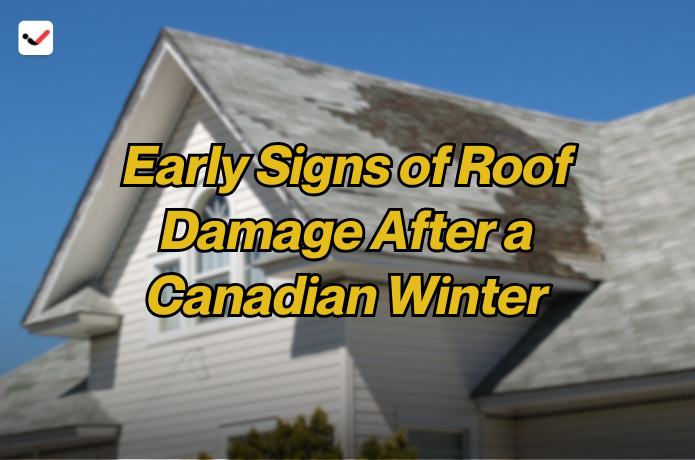Early Signs of Roof Damage After a Canadian Winter
Early Signs of Roof Damage After a Canadian Winter

Canadian winters are known for their heavy snow, freezing rain, and strong winds. While these conditions make for a beautiful season, they can also be tough on your home—especially the roof. Your roof is your home’s first line of defence against the elements, and it takes a beating every winter. Once the snow melts, it’s important to check for signs of roof damage before small problems turn into expensive repairs.
Many homeowners don’t realize their roof has been damaged until they notice a leak or a draft. But the earlier you spot warning signs, the better chance you have of fixing the issue without spending a lot of money. Knowing what to look for after a long winter can help you keep your home safe and dry. In this article, we’ll go over the early signs of roof damage and why roof inspections are especially important for Canadian homes.
1. Missing or Loose Shingles
One of the first things you should check after winter is the condition of your shingles. Strong winds and heavy snow can cause shingles to loosen or fly off completely. Look for any spots on the roof where shingles are missing, broken, or curling at the edges. These areas can easily lead to water leaks once spring rain begins.
If you see shingles in your yard or around your home’s foundation, that’s a clear sign you may have roof damage. Replacing damaged shingles early can prevent water from seeping into your attic or walls. It’s also a good idea to check for discoloured or worn-out shingles, which may need to be replaced even if they’re still attached.
2. Ice Dam Formation
Ice dams are a common problem in many parts of Canada. They form when snow on your roof melts and then refreezes near the edges, blocking water from draining properly. This trapped water can back up under the shingles and cause leaks in your ceiling or walls.
If you noticed large icicles or thick ridges of ice along your roofline during winter, your roof might be at risk. After the snow melts, check for signs of water stains on the ceilings or peeling paint on the walls inside your home. These are signs that water might have leaked through due to ice dam damage.
3. Water Stains or Leaks Inside the Home
Even if your roof looks fine from the outside, there may be damage underneath. One of the most obvious early signs of roof damage is water stains on your ceiling or walls. These often look like brown or yellow patches and can appear suddenly after the snow begins to melt.
You may also notice a musty smell or see signs of mold in your attic. These are clues that water has found its way in, even if you haven’t seen it dripping yet. A leaking roof in Canada can quickly lead to more serious damage, including rotten wood and insulation problems, so it’s best to act as soon as you spot anything unusual.
4. Sagging or Drooping Roofline
Take a step back from your home and look at the shape of your roof. A sagging or drooping roofline is a serious sign of roof damage and could mean your roof structure has been weakened by snow buildup or trapped moisture. This is especially common in older homes or roofs that haven’t been maintained properly.
If your roof looks uneven or dips in the middle, call a roofing contractor right away. It’s not just a cosmetic issue—this kind of damage can affect the safety of your home. In some cases, it might even mean the roof is at risk of collapse if not repaired in time.
5. Cracked or Damaged Flashing
Flashing is the metal or rubber material placed around vents, chimneys, and skylights to keep water out. Winter’s freeze-thaw cycles can cause flashing to crack or lift, allowing water to get underneath. If your roof flashing is damaged, you might notice leaks around these areas first.
Inspect your roof flashing closely or hire a roofing expert to check for damage. Replacing or repairing flashing is often a simple fix, but it can save you from major water damage if caught early. In Canadian homes where snow and ice stay on the roof for months, flashing is one of the first areas to fail if not properly sealed.
6. Granules in Gutters
Asphalt shingles have a layer of granules on them that help protect against sun damage and wear. After a harsh winter, these granules can start to wear off. If you clean your gutters and notice a lot of sandy material in them, it could mean your shingles are breaking down.
While some granule loss is normal, large amounts can be a sign that your roof is nearing the end of its lifespan. This is especially common after several tough winters. If you see this kind of wear, consider getting a full roof inspection to assess whether it’s time for a roof replacement.
7. Drafts or Rising Energy Bills
If your home suddenly feels colder or your heating bills are going up, roof damage might be to blame. Gaps in your roof or attic insulation caused by winter wear and tear can allow cold air to enter. This forces your heating system to work harder, which can lead to higher energy bills.
Check for drafts in the attic and around ceiling light fixtures. A cold attic in winter is normal, but it should be properly sealed and ventilated. If your attic is unusually warm or cold depending on the season, your roof may need repair. In Canada’s cold climate, energy efficiency is an important part of home maintenance, and roof condition plays a big role in it.
8. Moss or Algae Growth
Once spring arrives, keep an eye out for moss or algae on your roof. These can grow when moisture is trapped on the surface, often as a result of poor drainage after snow and ice. Moss can lift shingles and trap even more water, leading to roof rot over time.
If you spot moss or dark streaks on your shingles, clean the area or have a professional remove the growth. Make sure your gutters and downspouts are clear to help water drain properly from the roof. Preventing moisture buildup is one of the best ways to avoid roof damage after a Canadian winter.
Roof maintenance is one of the most important parts of caring for your home in Canada. Winters here can be rough, and small issues can quickly turn into big repairs if ignored. By learning to spot early signs of roof damage like missing shingles, leaks, or sagging areas, you can take action early and avoid costly repairs down the road.
If you're unsure about the condition of your roof, consider scheduling a professional roof inspection in early spring. A licensed roofing contractor can spot hidden problems and suggest the best solutions. Keeping your roof in good shape not only protects your home but also helps keep your family safe and warm all year long.

